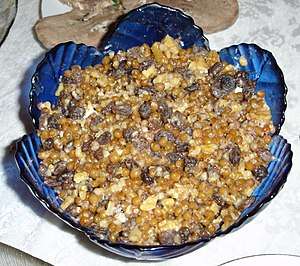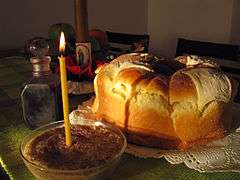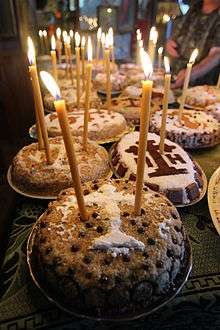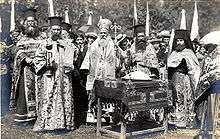Koliva
Koliva, also spelled kollyva, kollyba or colivă,[lower-alpha 1] is a dish based on boiled wheat that is used liturgically in the Eastern Orthodox Church for commemorations of the dead.
 Koliva from wheat seeds with raisins | |
| Alternative names | Kollyva, Colivă, Funeral Cake |
|---|---|
| Type | Ritual food |
| Main ingredients | Wheat kernels, honey or sugar |
In the Eastern Orthodox Church, koliva is blessed during funerals, as well as during the memorial service (mnemosyno) that is performed at various intervals after a person's death and on special occasions, such as the Saturday of Souls (ψυχοσάββατο). It may also be used on the first Friday of Great Lent,[1] at Slavas, or at mnemosyna in the Christmas meal. In some countries, though not in Greece and Romania, it is consumed on nonreligious occasions as well.
A similar food item is widely popular in Lebanon where it is known as snuniye and, more commonly, as berbara as it is prepared for Saint Barbara's feast day, December 4, which is celebrated with Halloween-like festivities.
Etymology
Kollyba, a word which in Greek is the plural form of kollybo (κόλλυβο: n neu; itself rarely used), is derived from the Classical Greek word κόλλυβος, kollybos (n masc), i.e. a small coin or a small gold weight. In the Hellenistic period, the neuter plural form of the latter word, i.e. κόλλυβα, kollyba, took the meaning of small pies made of boiled wheat.The sense of the ritual food is of a latter period.[2][3]
Recipe

While recipes may vary widely, the primary ingredient is wheat kernels which have been boiled until they are soft, they are drained very well and spread on a cloth to be just moist, and then sweetened with honey or sugar. Koliva also contains some or all of the following: wheat, sesame seeds, almonds, ground walnuts, cinnamon, sugar, pomegranate seeds, raisins, anise and parsley.[4] Romanians decorate the koliva with crosses of cocoa, chocolate or candy. In terms of the Greek Pantheon, the wheat symbolized the earth goddess Demeter, while pomegranates stood for her daughter, Persephone, queen of the underworld. Almonds were sacred to Aphrodite and raisins to Dionysus. Sesame seeds were considered to open the doors of consciousness.
The practice of offering koliva is traditional in Greece, Cyprus, Bulgaria, Romania, Moldova, Russia and Balkan countries, and among Christians in the Middle East. When served, the koliva mixture, which looks like earth, is shaped into a mound to resemble a grave. The whole is then covered with powdered sugar and the initials of the deceased are outlined on the top. A candle, usually placed in the center of the koliva, is lit at the beginning of the memorial service and extinguished at its end. After the liturgy, those attending share in eating the koliva as they speak of the deceased and say, "May God forgive him/her."
Some Orthodox parishes have a designated individual charged with making the koliva. This is in part due to the health risk of fermented wheat if the koliva is not prepared correctly.
Sometimes koliva is made with rice or barley instead of wheat. This custom began as a practical response to a famine that occurred in Soviet Russia, when the faithful did not have wheat available for koliva, so they used rice instead. Some communities continue to use rice for their koliva to this day. In the Japanese Orthodox Church where rice is mainly eaten, koliva is commonly made from rice sweetened with sugar and decorated with raisins, without reference to famine.
History
The origins of koliva predate Christianity. The word koliva itself stems from the Ancient Greek word κόλλυβoς (kollybos), which originally meant "a small coin" and later in the neuter plural form "small pies made of boiled wheat". In the Ancient Greek panspermia, a mixture of cooked seeds and nuts were offered during the pagan festival of the Anthesteria. For this reason, in Greece koliva is also called sperma, i.e. seed(s).
In the 5th century AD koliva in the sense of boiled wheat, constituted along with raw vegetables the diet of monks who refused to eat bread.[5] The 12th century canonist Theodore Balsamon maintained that koliva as a ritual food practice was originated by Athanasius of Alexandria during the reign of the Emperor Julian the Apostate.[6]
The association between death and life, between that which is planted in the ground and that which emerges, is deeply embedded in the making and eating of koliva. The ritual food passed from paganism to early Christianity in Byzantium and later spread to the entire Orthodox world.
Christian interpretation

Orthodox Christians consider koliva to be the symbolic of death and resurrection, according to the words of the Gospel:
Verily, verily, I say unto you, Except a grain of wheat fall into the ground and die, it abideth alone: but if it die, it bringeth forth much fruit. (John 12:24)
Wheat which is planted in the earth and rises in new life is symbolic of those beloved departed who have died in the hope of resurrection, in accordance with the words of Saint Paul:
So also is the resurrection of the dead. It is sown in corruption, it is raised in incorruption. It is sown in dishonour, it is raised in glory. It is sown in weakness, it is raised in power. It is sown a natural body, it is raised a spiritual body....(1 Corinthians 15:42-44)
This symbolism has its highest expression in the Saints, whose blessed state in heaven have been manifested to the world. For this reason, koliva is blessed not only at memorials for the departed, but also in commemoration of saints.
Occasions of use

Koliva is used on a number of different occasions:
St Theodore Saturday
The tradition of blessing and eating koliva at the end of the first week of Great Lent is connected with an event in the reign of Julian the Apostate. The tradition states that the Emperor knew that the Christians would be hungry after the first week of strict fasting, and would go to the marketplaces of Constantinople on Saturday to buy food. So he ordered that blood from pagan sacrifices be sprinkled over all the food that was sold there. This made the food unsuitable as Lenten fare (since the Christians could not eat meat products during Lent), and in general as food for Christians, who are forbidden to eat food from such sacrifices. However, St. Theodore Tyro appeared in the dream to Archbishop Eudoxius and advised him that the people should not eat food bought at the marketplace that day, but only boiled wheat mixed with honey.[7] As a result, this first Saturday of Great Lent has come to be known as Theodore Saturday.
Memorial services
During requiem services (Greek: mnemósynon, Slavonic: Panikhida, Romanian: parastas), the family or friends of the departed will often prepare a koliva which is placed in front of the memorial table before which the service is chanted.
Memorial services are held on the third, ninth, and fortieth days after the repose of an Orthodox Christian, as well as on the one-year anniversary. In addition, there are several Soul Saturdays during the church year (mostly during Great Lent), as well as Radonitsa (on the second Tuesday after Pascha), on each of which general commemorations are made for all the departed.
Funerals
During the Greek, Romanian, Bulgarian and Serbian funeral services it is offered to all who attend the funeral.
Commemoration of saints
It is also customary in the Slavic practice on the feast of the Patron Saint of a church or of a family, or on the feast of saints of special significance to offer koliva. Instead of serving a memorial service, the koliva is set in front of an icon of the saint and a Moleben is served to that saint.
See also
- Kollyvades Movement
- Memorial service (Orthodox)
- Prayer for the dead
- Kutia - a sweet grain pudding, traditionally served in Russian, Belarus, Ukrainian, Polish and Lithuanian cultures.
- Panikhida
- Prosphora
- Radonitsa
- Saturday of Souls
Notes
- There are many variations of the name in the languages of Eastern Europe and the Mediterranean region. Greek: κόλλυβα (pronounced [ˈkoliva]), Cypriot Greek: κόλλυφα, “kollifa”, Serbian: кољиво, koljivo (also interchangeably called жито, žito), Romanian: colivă, Bulgarian: коливо, kolivo, Georgian: კოლიო, kolio (also interchangeably called კორკოტი, korkoti and წანდილი, tsandili), Ukrainian: коливо, kolyvo.
References
- "1st Saturday of Great Lent St Theodore the Recruit". Retrieved 2007-03-02.
- κόλλυβος. Liddell, Henry George; Scott, Robert; A Greek–English Lexicon at the Perseus Project.
- κόλλυβα, Dictionary of Standard Modern Greek (in Greek), Center for the Greek Language
- Lazarou, Stalo. "foodmuseum.cs.ucy.ac.cy" (in Greek). Cyprus Food Virtual Museum. Retrieved 27 November 2015.
- Kazhdan, Alexander P., ed. (1991). "KOLLYBA". The Oxford Dictionary of Byzantium. Oxford University Press. Available (limitedly) online at the Oxford Reference.
- Chambers, Ephraim. "Colyba". Cyclopædia. University of Wisconsin Digital Collections. Archived from the original on September 16, 2010.
- THE FEAST OF THE BOILED WHEAT MIRACLE AT THE PATRIARCHATE. JERUSALEM PATRIARCHATE Official News Gate. 04/03/2017. Retrieved: 6 March 2017.